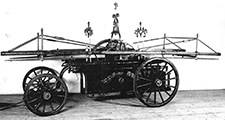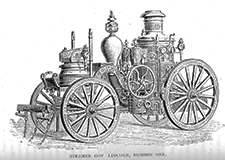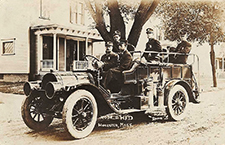
As Worcester grew from a village into a small town in 18th & 19th centuries, residents had seen an increase in fires that affected the community. Guaranteed, if not caught quickly, a fire would result in a complete loss of property or worse. One example that would lead to many changes in fire protection was a fire that destroyed the house of Captain Benjamin Flagg in 1786. After the loss of his property, Captain Flagg led the charge to convince the town to buy a fire engine. When the town took no action, he worked with other prominent members of the town to form the Worcester Fire Society to gain a louder voice of persuasion.
Worcester Fire Society was instrumental in convincing the town's folk to purchase an engine. They required their members to purchase their own fire buckets, poles and ladders. Members would fight the fires with the assistance of ordinary citizens. Worcester finally obtained its first "hand" fire engine in 1793.
 By 1828 Worcester had four engine companies comprised of volunteers whose duties included responding to the firehouse, getting the engine to the fire, manning the engine at the scene and returning to the firehouse when the fire was out.
By 1828 Worcester had four engine companies comprised of volunteers whose duties included responding to the firehouse, getting the engine to the fire, manning the engine at the scene and returning to the firehouse when the fire was out.
On February 25, 1835, the Worcester Fire Department was officially established by an act of the state legislature. In May of 1835 the Board of Selectmen appointed the first Board of Engineers for the Fire Department. With the establishment of the Fire Department, the efforts of the volunteers were channeled into the Fire Department, which was directly under the control of the town government. Although these firemen were not full time and had other means of livelihood, Worcester was one of the first towns in the country to pay its firefighters.
 In the 1860s the department began its conversion to steam engines. The town purchased three steam engines between 1860 and 1866, thus eliminating the need for most of the old "hand" engines. In 1867, in order to pull its new steam engines, Worcester began to acquire fire horses. Up until that time, horses had been hired to pull the equipment as the need arose. The drivers of the steam engines were the first full time members of the Department and were charged with training and caring for the animals and keeping them ready for duty in case of a fire. The number of horses owned by the department rose to a high of 87 in 1911. The final horse was retired in 1932.
In the 1860s the department began its conversion to steam engines. The town purchased three steam engines between 1860 and 1866, thus eliminating the need for most of the old "hand" engines. In 1867, in order to pull its new steam engines, Worcester began to acquire fire horses. Up until that time, horses had been hired to pull the equipment as the need arose. The drivers of the steam engines were the first full time members of the Department and were charged with training and caring for the animals and keeping them ready for duty in case of a fire. The number of horses owned by the department rose to a high of 87 in 1911. The final horse was retired in 1932.
Worcester resident Thomas Maloney, "a worthy and faithful member of Hook and Ladder Co. No. 2," was critically injured when struck by the collapsing wall of a burning building. Maloney was part of a contingent of Worcester firemen who were sent to fight the Great Boston Fire of 1872. Maloney died of his injuries November 20, 1872, becoming the first member of the Worcester Fire Department to die in the performance of his duty. Since then, there has been over 40 Line of Duty Deaths in the Worcester Fire Department.
In 1880, the first brass sliding pole used in the country was installed in Worcester. Although the wooden pole was invented in Chicago in 1878, Captain Charles Allen of Engine 1 invented the metal sliding pole.
 By 1910 the WFD moved toward the complete motorization of its equipment. In that year the Department put into service a Pope-Hartford automobile hose wagon. Motorization continued at a rapid pace and in 1925 the last steam fire engine, Engine Co. 3 stationed on School Street was retired. By 1935 the WFD consisted of ten engine companies, ten ladder companies and ten hose wagons.
By 1910 the WFD moved toward the complete motorization of its equipment. In that year the Department put into service a Pope-Hartford automobile hose wagon. Motorization continued at a rapid pace and in 1925 the last steam fire engine, Engine Co. 3 stationed on School Street was retired. By 1935 the WFD consisted of ten engine companies, ten ladder companies and ten hose wagons.
Maybe the greatest tragedy in the history of the Worcester Fire Department, the 1999 Worcester Cold Storage Warehouse Fire, still remains burned into some of our memories. Yet, with each passing year, with many men who worked beside them retiring and soon to have new firefighters enter the department who were born after the tradgedy, how do we keep the promise? The promise we all made, the promise drawn by school children on homemade signs, the promise that made the front pages & billboards; "Never Forget." What are the names of the other men of the WFD that lost their lives in the line of duty? You didn't forget, you probably never knew. History is trapped inside of each one of us and if you don't tell the tale, it my die with you.
The Worcester Fire Museum and Educational Center is the next step to take to keep our promise, not just the ones made in 1999 but of those made to FF Jon Davies in 2011, FF Christopher Roy in 2018, Lt. Jason Menard in 2019 and those made to all those members who have given the supreme sacrifice.
The Worcester Fire Museum and Educational Center is expected to be housed in space on the east side of Union Station and will contain a variety of artifacts, memorabilia and displays, conference room space with state-of-the-art audio and visual equipment and will also be home to the Public Education and Community Risk Reducation Division of the Fire Department.
To learn more, become a member or make a donation, please visit: www.WFDmuseum.com.
Click on a thumbnail below to view the full-sized image.